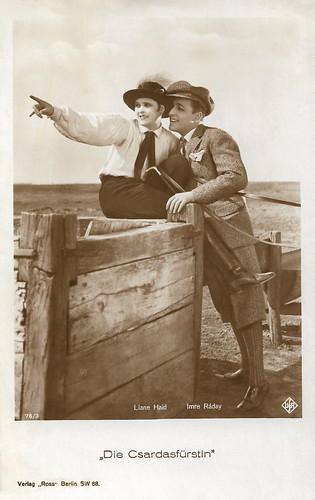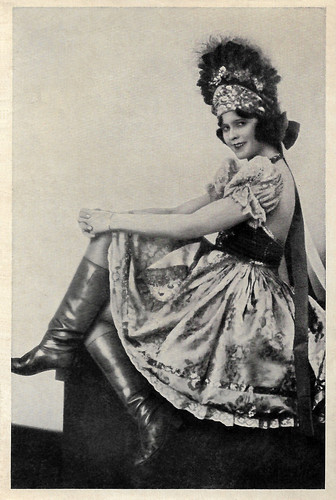
German postcard by Ross Verlag, no. 1732/2, 1927-1928. Photo: Ufa. Liane Haid in Die Csardasfürstin/The Csardas Princess (Hanns Schwarz, 1927). Collection: Didier Hanson.

German postcard by Ross Verlag, Berlin, no. 76/1. Photo: Ufa. Liane Haid in Die Csardasfürstin/The Csardas Princess (Hanns Schwarz, 1927).

German postcard by Ross Verlag, Berlin, no. 76/2. Photo: Ufa. Liane Haid and Oscar Marion in Die Csardasfürstin/The Csardas Princess (Hanns Schwarz, 1927).

German postcard by Ross Verlag, no. 76/4. Photo: Ufa. Liane Haid in Die Csardasfürstin/The Csardas Princess (Hanns Schwarz, 1927). The young man with the cap is Imre Ráday.
A silent operetta
The German-Hungarian coproduction Die Czardasfürstin/The Csardas Princess (1927) is a silent romance directed by Hanns Schwarz. The film was produced by Peter Ostermayr Produktion, supported by the Hungarian Film Fund, and was distributed by the Ufa. The exteriors were shot in Hungary and the film was finished at Ufa's Babelsberg Studios in Berlin.
The film is based on the 1915 operetta 'Die Csárdásfürstin' by Hungarian composer Emmerich Kálmán (Hungarian: Kálmán Imre). Kálmán's compositional style was influenced by Hungarian folk music and the title of his operetta refers to the popular Hungarian Csárdás dance. 'Die Csárdásfürstin' remains Kálmán's most successful operetta.
Emmerich Kálmán was a prominent figure in the development of Viennese operetta in the 20th century. Among his most popular works are 'Die Csárdásfürstin' (1915), 'Gräfin Mariza' (Countess Maritza, 1924) and 'Die Zirkusprinzessin' (The Circus Princess, 1926). These operettas were in the Viennese style of precursors such as Johann Strauss II and Franz Lehár. As a result of the Anschluss in 1936, Kálmán and his family fled to Paris and then to the United States. His later works were influenced by American jazz.
The silent film version, Die Czardasfürstin/The Csardas Princess (1927) had an Austrian-Hungarian cast. Austria's first film star, Liane Haid played Sylva Verescu, the Csardas Princess. Her three admirers were played by Imre Ráday in his film debut, Ferenc Vendrey, and the popular film star Oscar Marion. Among the supporting players was the Italian film actor Oreste Bilancia.
Hanns Schwarz's Die Czardasfürstin/The Csardas Princess (1927) was not the first silent film version of the operetta. The first version was the German film Die Csardasfürstin/The Csardas Princess (Emil Leyde, 1919). Many sound films followed. In 1944 it was made into the Soviet operetta film Silva (Aleksandr Ivanovsky, 1944). It was one of the most successful releases in the Soviet Union that year. In 1981, it was made again into another successful Soviet operetta film, Silva (Yan Frid, 1981).

German postcard by Ross Verlag, Berlin, no. 76/3. Photo: Ufa. Liane Haid and Imre Ráday in Die Csardasfürstin/The Csardas Princess (Hanns Schwarz, 1927).

German collectors card in the series 'Vom Werden deutscher Filmkunst - Der Tonfilm', album no. 11, picture no. 136, group 44. Photo: Ufa / Ross Verlag. Liane Haid in Die Csardasfürstin/The Csardas Princess (Hanns Schwarz, 1927).

German postcard by Ross Verlag, no. 1732/2, 1927-1928. Photo: Ufa.
Sources: Wikipedia (German and English) and IMDb.
No comments:
Post a Comment